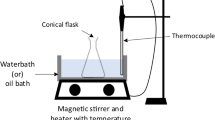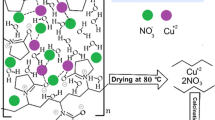Abstract—
Cu, Cu@Cu2O, and CuO nanoparticles have been prepared by the induction flow levitation method using bulk copper. The method offers a number of advantages, such as a high production rate, continuity of the nanoparticle synthesis process, the ability to vary the nanoparticle size in a wide range, and contactless heating, which ensures high purity of the synthesis product. To obtain nanoparticles with a core–shell structure and copper oxide nanoparticles, oxygen was introduced into different zones of the quartz reactor used. The synthesized nanoparticles have been characterized by a number of physicochemical methods.








Similar content being viewed by others
REFERENCES
Feynman, R., Nanomaterials, Nanomaterials, 2009, pp. 1–20.
Taylor, R., Coulombe, S., Otanicar, T., Phelan, P., Gunawan, A., Lv, W., Rosengarten, G., Prasher, R., and Tyagi, H., Small particles, big impacts: a review of the diverse applications of nanofluids, J. Appl. Phys., 2013, vol. 113, no. 1, p. 011301.
Astruc, D., Introduction: nanoparticles in catalysis, Chem. Rev., 2020, vol. 120, no. 2, pp. 461–463.
Malekzad, H., Sahandi Zangabad, P., Mirshekari, H., Karimi, M., and Hamblin, M., Noble metal nanoparticles in biosensors: recent studies and applications, Nanotechnol. Rev., 2017, vol. 6, no. 3, pp. 301–329.
Liu, S., Fu, S., Zhang, X., Wang, X., Kang, L., Han, X., Chen, X., Wu, J., and Liu, Y., UV-resistant holographic data storage in noble-metal/semiconductor nanocomposite films with electron-acceptors, Opt. Mater. Express, 2018, vol. 8, no. 5, pp. 1143–1153.
Taylor, R., Phelan, P., Otanicar, T., Adrian, R., and Prasher, R., Nanofluid optical property characterization: towards efficient direct absorption solar collectors, Nanoscale Res. Lett., 2011, vol. 6, no. 1, pp. 1–11.
Abass, S.M., Sunitha, S., Ashaq, S.M., Khadheer, P.S., and Choi, D., An overview of antimicrobial and anticancer potential of silver nanoparticles, J. King Saud Univ., Sci., 2022, vol. 34, no. 2, p. 101791.
Ullah, K.A., Chen, L., and Ge, G., Recent development for biomedical applications of magnetic nanoparticles, Inorg. Chem. Commun., 2021, vol. 134, p. 108995.
Shahbazali, E., Hessel, V., Noël, T., and Wang, Q., Metallic nanoparticles made in flow and their catalytic applications in organic synthesis, Nanotechnol. Rev., 2014, vol. 3, no. 1, pp. 65–86.
Ojha, N., Zyryanov, G., Majee, A., Charushin, V., Chupakhin, O., and Santra, S., Copper nanoparticles as inexpensive and efficient catalyst: a valuable contribution in organic synthesis, Coord. Chem. Rev., 2017, vol. 353, pp. 1–57.
Fathima, J., Pugazhendhi, A., Oves, M., and Venis, R., Synthesis of eco-friendly copper nanoparticles for augmentation of catalytic degradation of organic dyes, J. Mol. Liq., 2018, vol. 260, pp. 1–8.
Kang, J., Kim, H., Ryu, J., Thomas, H.H., Jang, S., and Joung, J., Inkjet printed electronics using copper nanoparticle ink, J. Mater. Sci. Mater. Electron., 2010, vol. 21, no. 11, pp. 1213–1220.
Kubota, S., Morioka, T., Takesue, M., Hayashi, H., Watanabe, M., and Smith, R., Continuous supercritical hydrothermal synthesis of dispersible zero-valent copper nanoparticles for ink applications in printed electronics, J. Supercrit. Fluids, 2014, vol. 86, pp. 33–40.
Kruk, T., Szczepanowicz, K., Stefanska, J., Socha, R., and Warszynski, P., Synthesis and antimicrobial activity of monodisperse copper nanoparticles, Colloids Surf. B, 2015, vol. 128, pp. 17–22.
Rajeshkumar, S., Menon, S., Venkat, K.S., Tambuwala, M., Bakshi, H., Mehta, M., Satija, S., Gupta, G., Chellappan, D., Thangavelu, L., and Dua, K., Antibacterial and antioxidant potential of biosynthesized copper nanoparticles mediated through Cissus arnotiana plant extract, J. Photochem. Photobiol., 2019, vol. 197, p. 111531.
Calabrese, C., La, P.V., Testa, M., and Liotta, L., Antifouling and antimicrobial activity of Ag, Cu and Fe nanoparticles supported on silica and titania, Inorg. Chim. Acta, 2022, vol. 529, p. 120636.
Yabuki, A. and Tanaka, S., Oxidation behavior of copper nanoparticles at low temperature, Mater. Res. Bull., 2011, vol. 46, no. 12, pp. 2323–2327.
Kim, I., Kim, Y., Woo, K., Ryu, E., Yon, K., Cao, G., and Moon, J., Synthesis of oxidation-resistant core–shell copper nanoparticles, RSC Adv., 2013, vol. 3, no. 35, pp. 15169–15177.
Wang, H., Cheng, S., Cai, X., Cheng, L., Zhou, R., Hou, T., and Li, Y., Photocatalytic CO2 reduction to HCOOH over core–shell Cu@Cu2O catalysts, Catal. Commun., 2022, vol. 162, p. 106372.
Kalidindi, S.B., Sanyal, U., and Jagirdar, B.R., Nanostructured Cu and Cu@Cu2O core shell catalysts for hydrogen generation from ammonia-borane, Phys. Chem. Chem. Phys., 2008, vol. 10, no. 38, pp. 5870–5874.
Mayyas, A., Wei, M., and Levis, G., Hydrogen as a long-term, large-scale energy storage solution when coupled with renewable energy sources or grids with dynamic electricity pricing schemes, Int. J. Hydrogen Energy, 2020, vol. 45, no. 33, pp. 16311–16325.
Sadrolhosseini, A., Noor, A., Shameli, K., Mamdoohi, G., Moksin, M., and Adzir, M.M., Laser ablation synthesis and optical properties of copper nanoparticles, J. Mater. Res., 2013, vol. 28, no. 18, pp. 2629–2636.
Khayati, G., Nourafkan, E., Karimi, G., and Moradgholi, J., Synthesis of cuprous oxide nanoparticles by mechanochemical oxidation of copper in high planetary energy ball mill, Adv. Powder Technol., 2013, vol. 24, no. 1, pp. 301–305.
Richter, K., Birkner, A., and Mudring, A., Stabilizer-free metal nanoparticles and metal–metal oxide nanocomposites with long-term stability prepared by physical vapor deposition into ionic liquids, Angew. Chem., Int. Ed., 2010, vol. 49, no. 13, pp. 2431–2435.
Jia, F., Zhang, L., Shang, X., and Yang, Y., Non-aqueous sol–gel approach towards the controllable synthesis of nickel nanospheres, nanowires, and nanoflowers, Adv. Mater., 2008, vol. 20, no. 5, pp. 1050–1054.
Zhang, Q., Yang, Z., Ding, B., Lan, X., and Guo, Y., Preparation of copper nanoparticles by chemical reduction method using potassium borohydride, Trans. Nonferrous Met. Soc. China, 2010, vol. 20, suppl. 1, pp. s240–s244.
Vijay, K.R., Elgamiel, R., Diamant, Y., Gedanken, A., and Norwig, J., Sonochemical preparation and characterization of nanocrystalline copper oxide embedded in poly(vinyl alcohol) and its effect on crystal growth of copper oxide, Langmuir, 2001, vol. 17, no. 5, pp. 1406–1410.
Huang, L., Jiang, H., Zhang, J., Zhang, Z., and Zhang, P., Synthesis of copper nanoparticles containing diamond-like carbon films by electrochemical method, Electrochem. Commun., 2006, vol. 8, no. 2, pp. 262–266.
Markov, A.N., Vorotyntsev, A.V., and Andronova, A.A., Direct synthesis of titanium nanoparticles by induction flow levitation technique, Key Eng. Mater., 2021, vol. 887, pp. 178–183.
Kuskov, M., Zhigach, A., Leipunsky, I., Afanasenkova, E., Safronova, O., Berezkina, N., and Vorobjeva, G., Synthesis of nanopowders of titanium compounds via flow-levitation method and study their properties, IOP Conf. Ser. Mater. Sci. Eng., 2019, vol. 558, no. 1, p. 012023.
Funding
This work was supported in part by the Russian Federation Ministry of Science and Higher Education (optimization of the operation of the experimental setup, research project no. FSWR-2022-0008) and Lobachevsky State University (physicochemical characterization of the materials, Priority 2030 Academic Leadership Program, project no. N-474-99, 2021–2023).
Author information
Authors and Affiliations
Corresponding author
Ethics declarations
The authors declare that they have no conflicts of interest.
Additional information
Translated by O. Tsarev
Rights and permissions
About this article
Cite this article
Kapinos, A.A., Markov, A.N., Petukhov, A.N. et al. Direct Synthesis of Copper and Copper Oxide Nanoparticles from Bulk Materials by the Induction Flow Levitation Technique. Inorg Mater 58, 931–938 (2022). https://doi.org/10.1134/S0020168522090060
Received:
Revised:
Accepted:
Published:
Issue Date:
DOI: https://doi.org/10.1134/S0020168522090060




